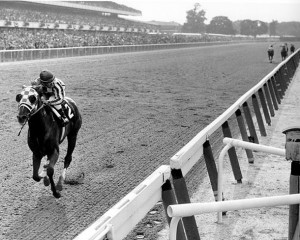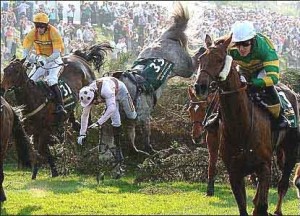Posted on
May 05, 2011 by
Dean Hybl

Secretariat dominated thoroughbred racing in 1973 and was named as the 35th greatest athlete of the 20th Century.
There was a time when the most important sporting event on the first weekend of May wasn’t the NBA or NHL Playoffs, but rather a two minute race between the fastest three-year-olds on four legs. While still an exciting event for those lucky enough to make it to Churchill Downs, the Kentucky Derby and thoroughbred racing in general isn’t quite the national obsession that it once was.
However, the history of this regal sport is laced with many great champions, some of whom captured the spirit and hearts of the American public.
While greatness for a thoroughbred is often identified with winning the famed Triple Crown (Kentucky Derby, Preakness Stakes and Belmont Stakes), only some of the best known horses actually claimed that distinguished honor.
Chances are you have never heard of the first Triple Crown winner, Sir Barton, in 1919, but may have heard about the legendary Man O’War, who many consider the greatest horse of all-time with victories in 20 of his 21 races. However, Man O’War did not follow Sir Barton as a Triple Crown winner during his three-year old year of 1920 as his owner held him out of the Kentucky Derby. Read the rest of this entry →
Tags: Horse RacingKentucky DerbyMan O' WarSecretariatsmarty jones
Category
Great Moments, Horse Racing, Sports History
Posted on
March 31, 2011 by
Rod Crowley

As is well known to racing fans all over the world, the Belmont Stakes is the third and final leg of the American Triple Crown of horse racing and is held each year at the Belmont Park racetrack in Elmont, New York. The race takes place five weeks after the Kentucky Derby, which is the first leg of the Triple Crown and three weeks after the Preakness Stakes, which of course is the second leg, it usually works out to be the first Saturday in June. It is run over 12 furlongs on a left-handed dirt track and is often referred to as “The Test of Champions” or the “Run for the Carnations”. Over its long history, it was first run in 1867, it has created its own unique set of records and statistics; here are some of them:
Jockeys
Eddie Arcaro and Jim McLaughlin lead the all time record of wins with six apiece, but the jockey with the biggest win percentage is Bill Shoemaker, who the race five times from just eleven attempts. The only current jockey with more than one win is Edgar Prado, who earned himself a somewhat unfair reputation as the man who spoils Triple Crown dreams. His first win came in 2002 aboard Sarava, whose win in the race ended the Triple Crown hopes of War Emblem, Prado won again in 2004 where he rode Birdstone to victory thus killing off the Triple Crown dream of the great Smarty Jones. Julie Krone is the only female jockey to have ridden the winner of the race, which came in 1993 aboard Colonial Affair.
Trainers
With eight wins in the race James G Rowe remains the trainer with the most wins, his last coming way back in 1913; Rowe also won the race twice as a jockey in 1872 and 1873, making him only one of two to achieve the feat, the other being George M Odom. Woody Stephens earned legendary status when he trained five consecutive winners between 1982-86. Nick Zito who has saddled two winners holds the record of 22 for sending out the most starters in the race, while D Wayne Lukas, with three winners is second after saddling 21 starters. Dermot Weld is the only current European trainer to have saddled the winner, that came in 1990 when Go And Go won the race with jockey, Mick Kinane on board.
Horses
There have been eleven Triple Crown winners, who completed the hat-trick by landing the Belmont Stakes, they are:
Sir Barton – 1919
Gallant Fox – 1930
Omaha – 1935
War Admiral – 1937
Whirlaway – 1941
Count Fleet – 1943
Assault – 1946
Citation – 1948
Secretariat – 1973
Seattle Slew – 1977
Affirmed – 1978
There have been a total of seven horses in the last 13 years who have come to the Belmont Stakes only to have their Triple Crown dream shattered; whilst there has been a total of 21 in all. The speed record for the race is held by Secretariat who won in 1973 with a time of 2:24secs, in winning he also created the record of 31 lengths of the widest ever margin of victory. The last non-American trained horse to win was Victory Gallop who was trained in Canada and is that country’s only ever success in the race.
Tags: belmont stakeshorsesjockeysrecordsstatstrainerswinners
Category
Horse Racing
Posted on
March 12, 2011 by
Pete South

Planet of Sound will likely miss the Gold Cup.
It looks as though there is bad news for fans of the Philip Hobbs-trained Planet of Sound, a lively outsider for next week’s feature Totesport Cheltenham Gold Cup, following the news that the talented gelding is suffering from an infection and is 95% certain not to be fit in time to take his chance in steeplechasing’s showcase event, writes Elliot Slater.
A downbeat Hobbs reported that the Kayf Tara gelding, (last seen when finishing fifth to Long Run in the King George VI Chase at Kempton in January having been a decent third to Imperial Commander and Tidal Bay in the Betfair Chase at Haydock in November on his previous start this term), is suffering from an infection in his hind leg and is undergoing treatment with antibiotics. The Minehead handler advised that time is running out to have the horse fit enough to take his chance next Friday as he is unable to put very much weight at all on the infected leg. Read the rest of this entry →
Tags: Planet of Sound
Category
Horse Racing
Posted on
March 09, 2011 by
John Williams

The Grand National offers a challenge for riders and horses.
The Grand National is the ultimate test of horse and rider with 40 horses taking on 30 huge fences over the 4m 4f course.
In the past the race was considered a bit of a lottery but over the past few years the improved jumping and ground conditions have attracted a better standard of horse in general and the professional punters have begun to take more of an interest.
With this in mind, it is more beneficial to look at the formbook and perhaps check out the free tips at OLBG, when trying to pick the winner. This is as opposed to plucking a name out of the office sweepstake.
When trying to narrow down the field to some good value selections the first variable to consider is the weight being carried by the horses.
Top-weight for the race this year is Don’t Push It (20/1), the horse that partnered Tony McCoy to victory last year. Asked by the handicapper to carry the most weight at 11st 12lb, the Jonjo O’Neill-trained runner has been largely ignored by the shrewd insiders so far. Read the rest of this entry →
Tags: Grand National
Category
Horse Racing
Posted on
March 09, 2011 by
Pete South

Twice Over is looking to win the Dubai World Cup.
Henry Cecil has revealed just how pleased he was with the winning performance of his high-class Twice Over on his first outing of the winter in Dubai last week, a victory that has catapulted the Prince Khaled Abdullah-owned horse to favoritism for the Dubai World Cup, the world’s richest race, set to take place in the desert kingdom on March 26, writes Elliot Slater.
Beaten favorite in last year’s World Cup, the policy of flying the son of Observatory out to the Middle East just a few days before the race appeared to backfire as the dual Champion Stakes winner ran a lack lustre race in finishing tenth behind the Brazilian bred Gloria de Campeao. This time around Cecil has adopted different tactics and sent Twice Over out to Dubai some weeks ago giving him more time to fully acclimatize to the conditions. Read the rest of this entry →
Tags: Horse RacingTwice Over
Category
Horse Racing
Posted on
February 22, 2011 by
Rod Crowley
 The Grade One Preakness Stakes is known also as the “The Run for the Black Eyed Susans” due to the blanket of the Maryland State flower being traditionally draped over the winner’s neck at the end of the race.
The Grade One Preakness Stakes is known also as the “The Run for the Black Eyed Susans” due to the blanket of the Maryland State flower being traditionally draped over the winner’s neck at the end of the race.
The race is run annually over 9½ furlongs on a dirt track at the world famous Pimlico Racecourse in Baltimore, Maryland and is recognized as the second leg of the highly coveted American Triple Crown, which comprises of the Kentucky Derby (first leg) and Belmont Stakes (third leg). The attendances at the race are the second highest in the sport, with only the Kentucky Derby at Churchill Downs attracting more spectators, in 2010, 95,760 people attended but that was down from over 121,000 in 2007 following the banning of fans being able to bring their own beer. The race is open to colts and fillies, with the ‘boys’ having to carry 126lb and the girls 5lbs less.
The history of the race dates back to 1873 (2 years before the Kentucky Derby) when Pimlico introduced a new quality Stakes race for three year olds. It was called Preakness in honour of a colt of the same name, who was the winner of the feature race on the day that Pimlico first opened in 1870. The first ever race was won by My Sheba who won by 10 lengths in fantastic style which remained the most emphatic victory in the race until 2004 when Smarty Jones, who had won the Kentucky Derby two weeks previously, came home by 11 lengths. Smarty Jones was then aimed at the Belmont Stakes where he became an odds on favorite in the Belmont Stakes betting to win the race and thus the coveted Triple Crown, which had not been won since Affirmed achieved the feat in 1977. In heart breaking fashion however this hugely popular colt, whose presence at Belmont Park had attracted it’s biggest ever crowd, was to be denied in the ‘Belmont’ by the late run of 36/1 outsider Birdstone. Read the rest of this entry →
Tags: belmont stakeshistorypimlicopreakness stakessmarty jones
Category
Horse Racing









